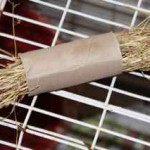The most important fun for guinea pigs is to have the company of other guinea pigs. But there are also other things you can supply to give your piggies a good time. For instance, you can scatter items for them to explore all over the main cage floor or the run (Hutchinson et al., 2005).
As well as a sleeping compartment, or a little house in the cage, guinea pigs enjoy hiding in other things too. These could include small cardboard boxes, cardboard rolls of the kind used to post large paper items, grass tunnels, willow tunnels of the kind made for rabbits, builder’s plastic piping. Just be careful that piping isn’t too long in case more than one guinea pig gets in there and a middle piggy is suffocated by one either end (Kaiser et al., 2010). Also make sure that the tubing is wide enough for all sizes of guinea pigs to fit through easily.
Also make sure that the tubing is wide enough for all sizes of guinea pigs to fit through easily.
Hay is a great toy as well as an important food (Reinhardt & Reinhardt 2006). As well as nibbling in it, guinea pigs can sort of tunnel into it. For a cheap toy pull hay through a toilet paper roll. You can do the same with clean long grass. Chew sticks of the kind sold for rabbits will be appreciated too (Baumans 2005) though avoid the very solid brightly coloured blocks sometimes sold in pet shops.
Though your guinea pig should have a basic unchanging diet of hay and a small amount of pellets, you can vary the veg! There’s nothing to stop you giving your piggy some of the vegetables you are going to eat yourself – though avoid lettuce and don’t feed too much spinach. Variety rather than too much of one kind of vegetable is good for all guinea pigs not just to make them happy, but also to keep them in good health.
Instead of putting the pellets in a bowl, scatter them on the floor so your guinea pig has to search for them.
STRESS…. Normal behaviour among guinea pigs is foraging, being social with other guinea pigs, squeaking, gnawing, and hiding. When they are stressed, guinea pigs may start fighting, stampeding, teeth chattering, biting the bars of their cage. If this is happening you need to make sure there are plenty of hiding plaes, things to chew and food to find.
Don’t move the hiding places (hay piles, little houses, boxes etc) when you clean them out. They will prefer them kept in the same places (Brandao & Mayer 2011). Never clean out every single area of the cage: leave some bedding or substrate uncleaned. That way the cage will keep a reassuring smell of home.
REFERENCES
Brandao, J. & Mayer J., (2011), ‘Behavior of Rodents with an Emphasison Enrichment,’ Journal of Exotic Pet Medicine, 20, 256–269
Baumans, V. (2005) ‘Environmental Enrichment for Laboratory Rodents and Rabbits: Requirements of Rodents, Rabbits, and Research,’ ILAR Journal, 46, 162-170
Hutchinson, E., Avery, A. & VandeWoude, S., (2005), ‘Environmental Enrichment for Laboratory Rodents,’ ILAR Journal, 46, 148-161.
Kaiser, S., Kruger, C. & Sachser, N, (2010), ‘The Guinea Pig,’ in eds Hubrecht & Kirkwood, J., The UFAW Handbook on Care and Management of Laboratory and other Research Animals, Eight Edition, Wiley-Blackwell, Chichester, UK, 381-398
Lee Y., (2010), ‘Guinea Pigs,’, ed Tyner, V. V., Behavior of Exotic Pets, Chichester, UK, Blackwell-Wiley, 78-90.
McBride, A., (2011), Guinea Pigs. Understanding and caring for your pet, Magnet & Steel.
Reinhardt, V. & Reinhardt, A., Variables, Refinement and Environmental Enrichment for Rodents and Rabbits kept in Research Institutions, Washington D. C., USA, Animal Welfare Institute